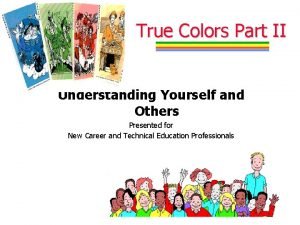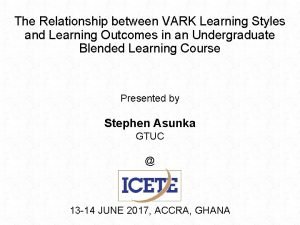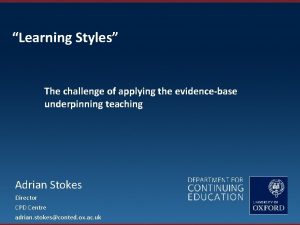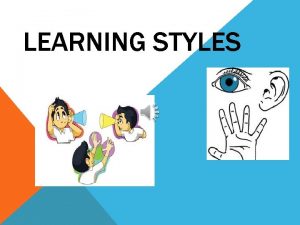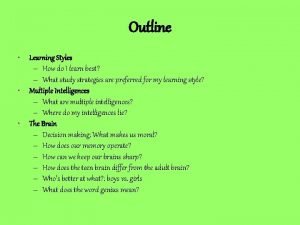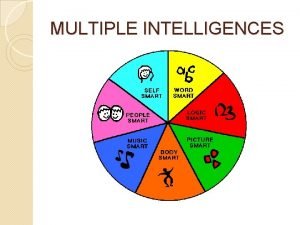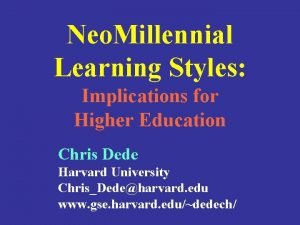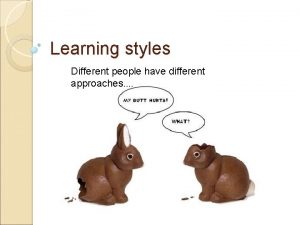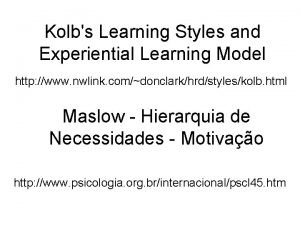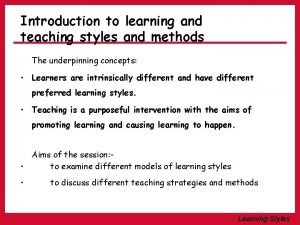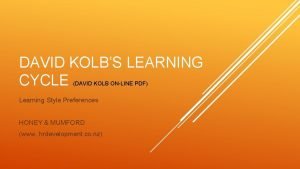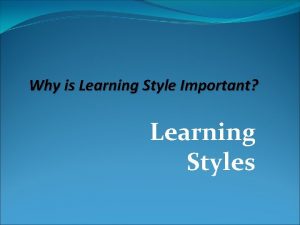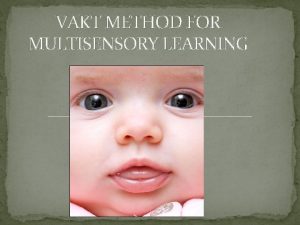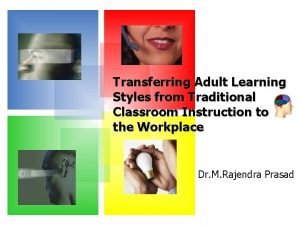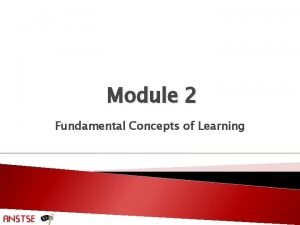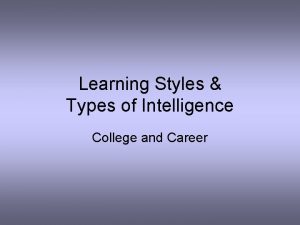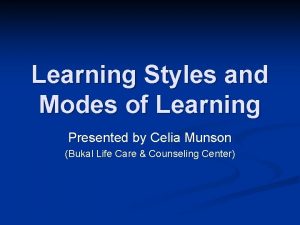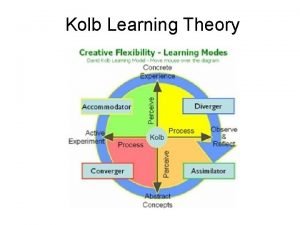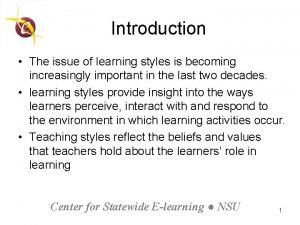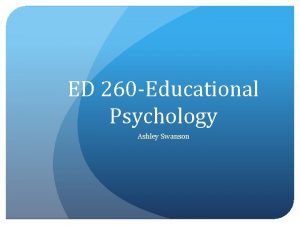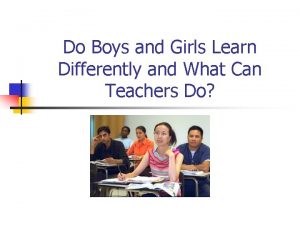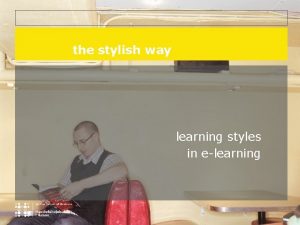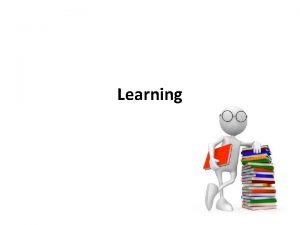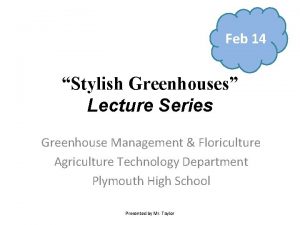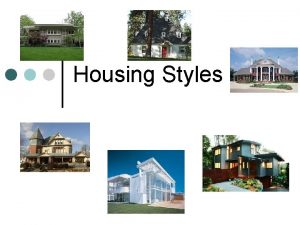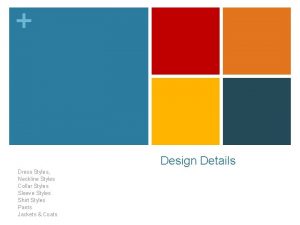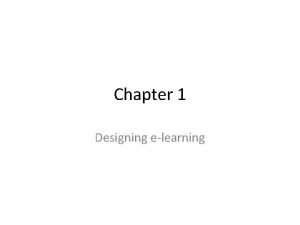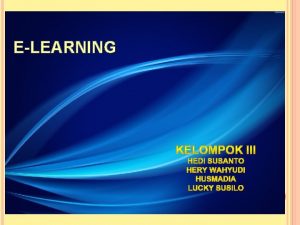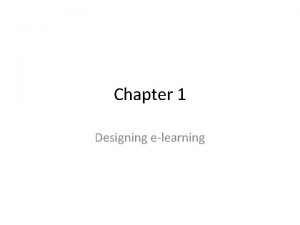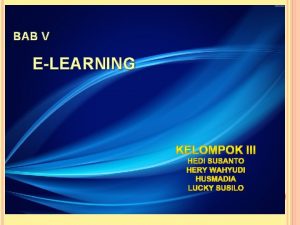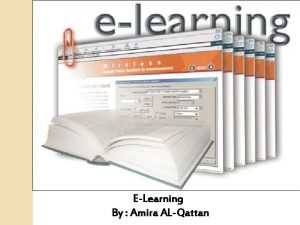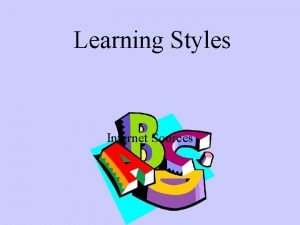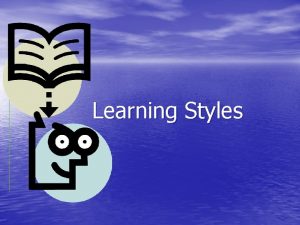the stylish way learning styles in elearning presentation




























- Slides: 28

the stylish way learning styles in e-learning

presentation Ole Lauridsen, Aarhus School of Business, Aarhus, DK mag. art. (≈ Ph. D) Professor of German Study Director of MILS (Master of ICT in Language Teaching and Learning)

program • what are learning styles (LS)? • which LS concepts are suitable in e-learning (and what is e-learning)? • the practical use of LS in e-learning? • a list of problems

what is e-learning? on-line learning • distance learning d e e • blended learning n n o i t the use of a z i d r a • online information retrieval d n ta S • CD-ROMs • web sites

e-learning standards International standardization • Information Technology for Learning, Education, and Training (ISO/IEC JTC 1 SC 36) • Collaborative Technology (ISO/IEC JTC 1 SC 36 WG 2)

what is e-learning? • e-learning • mere online learning = distance learning virtual classroom virtual university • tel(l) cal(l) cbs… • the mere use of ICT in the learning process = supplement to F 2 F subset of e-learning

learning styles: problems of definition • It has yet to be precisely (or singularly) defined. Terry O’Connor • People rely on personally constructed filters to orient their relationships towards the world. These filters [depend on] age, experience, internal psychodynamics, maturity, cognition, physiology, biochemistry, and so on. Since no one [can switch endlessly] between all these filters, … each individual has a unique approach to perceive, understand, and plan his/her interactions. … Our personal way of selecting can be described as our style. Terry O’Connor

cognitive styles • the ways in which the individual takes in new information in a broad perspective • the ways in which the individual thinks and recollects • the ways in which the individual solves problems • thus the cognitive styles have a significant impact on the opinions, the values, and the socialization of the individual

learning styles: definition • learning styles are the ways in which the individual takes in new information in an educational context • there will be large overlaps between cognitive styles and learning styles; to a large extent, learning is part of everyday life, and vice versa • living in the learning society, I would give up the distinction altogether

learning styles: definition • the way in which the individual learns: his/her strengths, strategies, tactics the layman’s definition • the way in which each individual learner begins to concentrate on, process, absorb, and retain new and difficult information Rita Dunn & Ken Dunn • individual differences in cognitive approach and process of learning Lynn Curry • perception and processing of new information David A. Kolb; Bernice Mc. Carthy

learning styles inventory • LS based on environment s • LS based on personality typology n o i at n i b m • LS based on intelligences co s u o i r a v • LS based on sensor modality n i – y nl o • LS based on perception m m o c e r o • LS based on information processing m r alo o – ne

LS: environment • external stimuli • sound • light • temperature • design of furniture in the classroom · ergonomy · aesthetics • (ICT: colors and layout in general)

LS: multiple intelligences Howard Gardner A new intelligence concept moving towards a pluralistic, contextual and distributive view and away from a psychometric and/or hierarchic one 7 intelligence modules: • body and movement • space • music • language • logic • intrapersonality • interpersonality

LS: personlity typology Myer-Brigg (Jung*) • E for extroversion • I for introversion • T for thinking • F for feeling • S for sensing • N for intuition • J for judgment • P for perception 16 types: ESTJ, INTP osv.

LS: sensor modality Russell French, Daryl Gilley, and Ed Cherry Print – printed or written text Visual – graphs and pics Auditive – listening Auditive Interactive – verbalizing Tactile – touching Tactile Kinesthetic – body movement Olfactory – smelling and tasting

LS: perception and processing (1) Anthong F. Gregorc and Kathleen A. Butler SEQUENTIAL PARTIAL/HOLISTIC CONCRETE C-S C–H ABSTRACT A–S A-H

LS: perception and processing (2) David A. Kolb divergers assimilators convergers accommodators

all concepts have the following features in common • all individuals have certain preferences • presumably, we can take it for granted that there are intrapersonal variations depending on the learning subject • the learning process should to a great extent implement as many styles as possible which will develop the individual and his/her learning potential

LS: “the natural selection” Perceptuelle stile Perceptual styles Sensor modalities • Kolb • • sequential/holistic sekventiel/holistisk • visual modality • auditive modality • taktil modality KOLB and THE 4 MAT SYSTEM Course Organizing ICT tools) Filter (ICT)

kolb < jung’s personality typology Jung worked with 8 typological groups: • 2 attitudes: introversion and extroversion objectivism • subjectivism 4 functions: • thinking, feeling - rational • intuition and sensing – irrational · the 4 functions can be realized as either introvert or extrovert

kolb < jung’s personality typology extrovert feeling intuition introvert sensing thinking

kolb

Te M ac M oti he St eth va r: im o to ul d: r/W at itt io ne n/ ss D is cu ss io n Processing: active Dynamic. FEELERS & Intuitive DOERS Learner ACTIVIST ACCOMMODATOR T M eac et h ho er d: : C Fa oa ci ch lit at io n KOLB Imaginative Learner FEELERS & WATCHERS PRAGMATIST DIVERGER ASSIMILATOR THEORIST REFLECTOR CONVERGER THINKERS & THINKERS Analytic- & Common Sense/ DOERS Theoretical Practical Learner WATCHERS Learner Intake: concrete M Student driven Concrete Experience ” er n Processing: reflective ch tio ea ma “T or r: nf he : I ac od Te eth Active Experimentation r to y ia ver ed co em i s r: / R f D he tor el ac ua : S Te al od Ev eth M Processing Perception Intake: abstract Abstract Conceptualization Perception Teacher driven Processing Reflective Observing

4 MAT® Concrete Experience R R WHY? WHAT IF? Active Experimentation L R doing/trying to, sensing/feeling, teach to others or oneself concrete examples, meaningful applications problem solving, problem predictions classifying, ordering, seeing relationships, comparing, prioritizing HOW? WHAT? L L Abstract Conceptualization L R Reflective Observing

4 MAT® Concrete Experience R R WHY? WHAT IF? Active Experimentation L R doing/trying to sensing/feeling, teach to others concrete examples, meaningful applications problem solving, predicting classifying, ordering, seeing relationships, comparing, prioritizing HOW? WHAT? L L Abstract Conceptualization L R Reflective Observing

the hemispheres direction of sight left hemisphere: right hemisphere: digitally analyzing, “western” analogically perceiving, “eastern” • language • numbers • logical sequences • reflection, etc. • space • colors • rhythm • intuition, etc. cognitive unity

Concrete Experience cises and web sites, communi-cation, role plays WHAT IF? HOW? web exercises & information retrieval, ICT tools (web & PC) R/L + sens. mod. text corpora, concordance programs, videos, chat WHY? WHAT? power point, interactive web pages, video/web conferencing R/L + sens. mod. Abstract Conceptualization Reflective observing on oc ICT and the 4 quadrants sh es ar s in w g rit (C in a g m Active experimentation ( p M us ar N ki et n) ) R/L + sens. mod. develop web exer- 4 MAT®

LS: problems • • fuzzy definitions diagnosing no broad longitudinal investigations of the effect what is good results and how can we measure them – grades? is it, after all, only the enthusiasm of the teacher and the charm of novelty that is crucial to apparently good results? time money wish
 Synonym for stylish
Synonym for stylish Cuadro comparativo de e-learning b-learning y m-learning
Cuadro comparativo de e-learning b-learning y m-learning True colors green
True colors green Vark learning styles fleming 1987
Vark learning styles fleming 1987 Education planner learning style quiz
Education planner learning style quiz Objectives of learning styles
Objectives of learning styles Outline learning styles
Outline learning styles Www. edutopia.org/multiple-intelligences-introduction
Www. edutopia.org/multiple-intelligences-introduction Seven learning styles
Seven learning styles Education styles
Education styles Objectives of learning styles
Objectives of learning styles 7 learning styles and vark similarities
7 learning styles and vark similarities Kolbs learning styles
Kolbs learning styles Communication styles driver analytical amiable expressive
Communication styles driver analytical amiable expressive Why is knowing your learning style important
Why is knowing your learning style important Socioculturalism
Socioculturalism Kolb's experiential learning cycle pdf
Kolb's experiential learning cycle pdf Conclusion of learning styles
Conclusion of learning styles Vakt learning styles
Vakt learning styles Adult learning styles
Adult learning styles Learning preferences
Learning preferences Self smart careers
Self smart careers Education styles
Education styles Kolb learning styles
Kolb learning styles Conclusion of learning styles
Conclusion of learning styles Multiple intelligences and learning styles
Multiple intelligences and learning styles Male vs female learning styles
Male vs female learning styles What is vark?
What is vark? What's a frequency table
What's a frequency table


